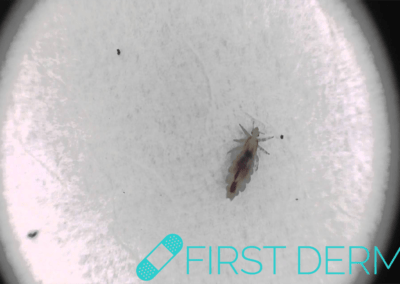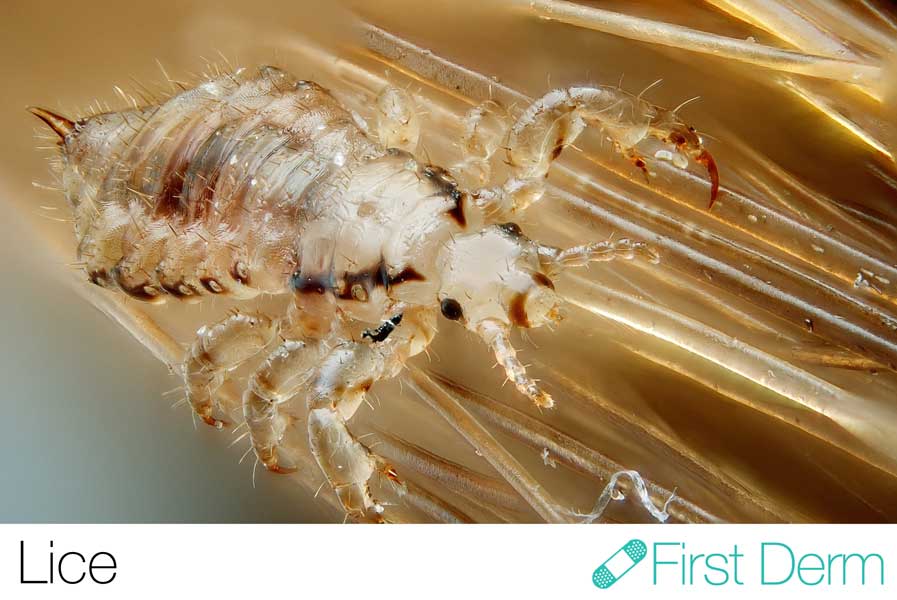Head Lice Infestation
Medically reviewed by The Dermatologists and written by Dr. Alexander Börve
Very Common
- Self-diagnosable
- Symptoms: Visible lice and/or lice eggs, itching
- Color: Typically white or transparent
- Location: Scalp
- Treatment: medical agents, medical conditioner, prescription drugs
If a child has an itch in the scalp, it can be a sign for possible infection with head lice. A lice infestation produces a small red rash that can sometimes be mistaken for eczema.
Symptoms
Head lice is one to three millimeters long and transparent and lives on human blood. Its color varies from gray, brown, black to red, depending on when they have sucked blood. It moves by climbing to the hair shaft, meaning that lice can be spread through contact head to head. Lice that ended up landing outside the hair dries out quickly and is not contagious. Therefore, the risk of spreading lice through caps and bedding is very small. Because head lice live on blood and not by dirt, anyone can get head lice. It has nothing to do with hygiene.
Try our FREE dermatology search engine and get peace of mind within a second
What can I do?
To check for head lice, look carefully for the minimal nits (eggshells) that are “glued” to the hair, not far from the scalp. You can also use a fine-toothed nit comb and a piece of white paper to check for lice. Be aware that they can appear on the neck as well.
Follow these steps:
- Comb your hair with conditioner. It is easier to detect lice if it is stuck. Make sure to comb through all the hair thoroughly from the scalp along the hair shaft.
- Apply the comb on a piece of white paper for each comb stroke. If there is lice in the hair, it will be stuck to the comb or the white paper.
- Look for lice eggs on the hair shaft near the scalp. They may be easier to detect than the lice itself. Egg containing prospective louses are dark, while empty eggs are bright, often yellowish-white, oval, about a millimeter long and follow the hair outgrowth.
If you find lice egg and there is no sign that you have live lice, do not start any treatment. The eggs often disappear when you hair grows out. You can try combing them away.
Follow these steps:
- Start combing with the back of your head by making a vertical parting and comb through to the sides. Make a new vertical parting and repeat through all your hair.
- Continue to comb through the hair at the crown. Repeat the same process.
- Comb the hair from your forehead to the neck, and then from the neck to forehead by repeating the same procedure.
Treatment with medical agents
If you discover lice, you should comb your hair thoroughly and regularly, two to three times a week. The most effective way to get rid of lice is to combine comb with treatment agents. You should not treat head lice as a preventive measure, because the risk of the more resistant lice increases. Ask a pharmacist when you choose a lice comb.
You can also try to treat the lice with a medical agent that contains dimethicone, a silicone oil. Cover your hair from scalp to the tip of your hair with the agent and follow instructions on the package. After the treatment, rinse and comb your hair to remove dead lice and eggs. The medical agent either smothers the lice or prevents the lice from forming liquid when they suck blood. Ask a pharmacist for options.
Continue to comb the hair thoroughly for two weeks after the last treatment with any agent. During those two weeks, you should comb the hair thoroughly two to three times a week, so you can be sure that the lice infestation has actually disappeared and did not come back. People around you should comb to be sure they do not also have lice.
If you find live lice, it may be because you have not followed the instructions for use carefully enough, or that you have new lice. It can also indicate that the lice have become resistant to the drug, particularly if you used an older drug. Then, you should change treatment to a medical agent, such flea powders with silicone oil.
Treatment with conditioner
You can also try to get rid of lice without the use of drugs by carefully combing dry hair with conditioner. But the effect is usually less effective than treatment with the various flea powders available on the market.
You have to comb your hair regularly, preferably every day, and very carefully for at least two weeks. A thorough combing takes at least 20-30 minutes. If your hair is long, it may take even longer.
Follow these steps:
- Rub the conditioner onto dry hair.
- Start by combing the hair with a regular comb or brush to untangle matted or tangled hair.
- Comb through the entire hair, bit by bit, with a fine-tooth comb. Repeat at least once.
- Rinse the comb each time you find a louse.
- Rinse your hair.
Try our FREE dermatology search engine and get peace of mind within a second
Should I seek medical care?
If you have tried different treatments but continue to find live lice, contact your healthcare provider.
Treatment
Lice can usually be treated by using over-the-counter or prescription medication. Prescription drugs that treat lice contain benzyl benzoate and disulfiram.
Source:
Head Lice. Laura Meister, Falk Ochsendorf. Dtsch Arztebl Int. 2016 Nov 11;113(45):763-772
Ask a Dermatologist
Anonymous, fast and secure!

The Specialist doctor from the University Hospital in Gothenburg, alumnus UC Berkeley. My doctoral dissertation is about Digital Health and I have published 5 scientific articles in teledermatology and artificial intelligence and others.



